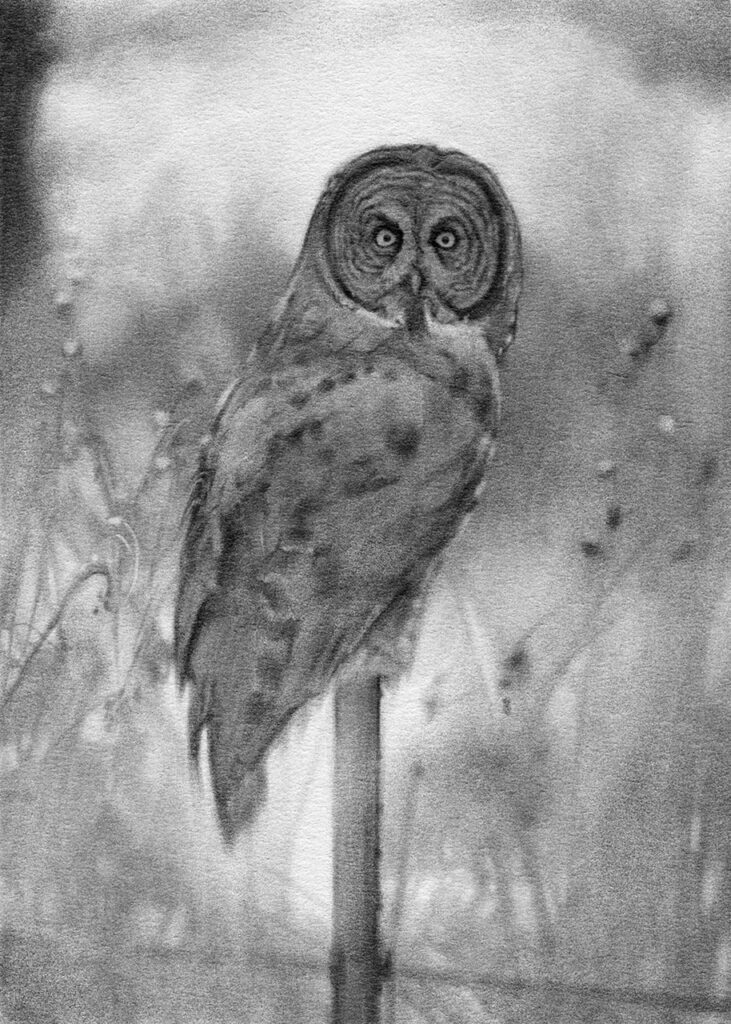Most birders have birds they would very much like to see but have not yet seen, ones that are
highly desired and sought after. For species repeatedly chased and missed and frustratingly
never where they should be, we grumble about nemesis birds, and hope for another try. For
rarities that show up when you are out of town or unable to twitch for work or family or financial
reasons, we bemoan missed opportunities (sometimes quietly, sometimes not). This often
leads to a feeling of not quite enough time, of always seeking the next lifer, of a constant quest
for, well, more. There other kinds of wish list species too, though. There are birds that hold
some combination of the above, but they also hover on the fringes of our imagination or
contain associations that extend beyond simple identification and capture. In short, there are
some species so awe-inspiring or meaningful that they hold magic.
For me, that species is (or at least one of them is) the Great Gray Owl. I am a birder who has
seen nearly all of the expected species that occur in the US ABA area, and yet I have never
seen one of these. It is not a nemesis bird for me but one I have lacked opportunities for. I have
been birding so many amazing places in the world, but never have I been in the time and place
where one of these magnificent owls might be.

The scientific name for Great Gray Owl is Strix nebulosa, a name that not only connotes
mystery but also literally means obscure, misty, foggy, cloudy. It translates from Spanish and
Portuguese directly to nebula, and when you start thinking on those lines you are mentally
traveling very far indeed. Many of my birding friends have booked trips specifically to look for
these owls of the northern forest; there are well-known locations in the US and Scandinavia to
tick them. For U.S. birders, Sax-Zim Bog in Minnesota or Yosemite in California are great
places to start.
While one can look for these birds in reliable areas, I have a slightly different dream in mind. I
really want to find one while hiking in Yellowstone National Park in Montana. As a note to
birders for whom listing is of primary importance, this is not a recommended strategy for
finding them (see the previous paragraph). The owls are in the park, but they are scattered
across a very large amount of habitat, and their locations are variable from year to year and
generally not publicly shared when found. But the thing is, Yellowstone is also a life experience
for me, one my Montana-born mother told me childhood stories about. It is a place she dearly
loved, full of animals that she loved, and it is a place I wanted to drive her back to before she
passed away. Sadly, I did not have the chance. Yellowstone National Park is one of the last
national parks in the U.S. that I have not yet seen. In my dream, I am hiking in one of our
country’s most impressive natural spectacles, combining a lifer park with my most wanted lifer
bird, in a context of great personal significance. The bird would be self-found, of course
(grinning; why not shoot for the moon?).
Citation: Bull, E. L. and J. R. Duncan (2020). Great Gray Owl (Strix nebulosa),
version 1.0. In Birds of the World (S. M. Billerman, Editor). Cornell Lab of Ornithology,
Ithaca, NY, USA. https://doi.org/10.2173/bow.grgowl.01